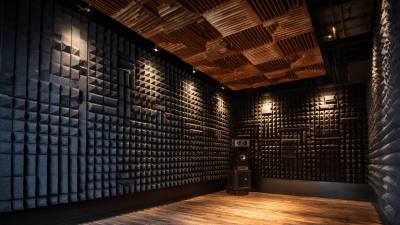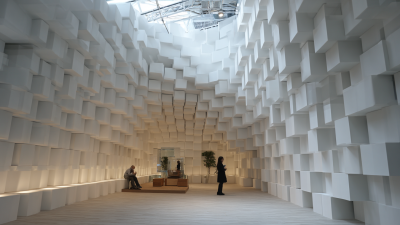 In today's fast-paced world, the environment we inhabit plays a crucial role in our overall well-being and productivity. Numerous studies indicate that sound quality significantly impacts our ability to concentrate and communicate effectively. According to a report by the National Institute of Health, poor acoustics can reduce productivity by up to 30%, highlighting the need for effective sound management solutions.
In today's fast-paced world, the environment we inhabit plays a crucial role in our overall well-being and productivity. Numerous studies indicate that sound quality significantly impacts our ability to concentrate and communicate effectively. According to a report by the National Institute of Health, poor acoustics can reduce productivity by up to 30%, highlighting the need for effective sound management solutions.
Acoustic wall panels are an innovative solution to this pervasive issue, designed to absorb sound and enhance the auditory landscape of any space. Research suggests that implementing these panels can improve sound quality by an impressive 40%, making them an essential addition to offices, homes, and public spaces alike.
By understanding the benefits and applications of acoustic wall panels, one can transform any environment into a sanctuary for enhanced focus and creativity.
Acoustic wall panels have become a go-to solution for enhancing sound quality in homes, with studies indicating that they can improve acoustics by up to 40%. According to the National Institute of Standards and Technology, poor acoustic environments can negatively impact speech intelligibility, making it difficult to communicate effectively. In residential settings, this is particularly relevant for home theaters, music rooms, and open-plan living spaces. By incorporating acoustic panels, homeowners can significantly reduce echo and background noise, which can create a more enjoyable and immersive auditory experience.
Research by the Acoustical Society of America shows that specifically designed acoustic treatments can lower sound pressure levels and minimize sound reflection, contributing to a calmer atmosphere. For instance, the implementation of wall panels made from sound-absorbing materials, such as fiberglass or foam, allows for absorption of sound waves, thus preventing disruptive noise from permeating living spaces. This leads to not just improved sound quality, but also a more aesthetically pleasing environment as these panels come in various styles and finishes that can complement interior design efforts.
Acoustic wall panels have gained recognition for their ability to enhance sound quality significantly, often improving it by as much as 40%. This remarkable improvement is deeply rooted in the science of sound waves and how they interact with various materials. Sound waves are vibrations that travel through the air and can reflect, absorb, or transmit once they encounter different surfaces. Understanding this dynamic is essential for optimizing acoustic environments, whether in a home theater, office, or music studio.
The effectiveness of acoustic panels lies in their design and the materials used for sound absorption. Many panels are made from porous substances like foam or fabric-wrapped fiberglass, which are specifically engineered to trap sound waves. When sound waves hit these surfaces, they penetrate into the material, dissipating energy and reducing echo and reverberation. This not only sharpens clarity in conversations and performances but also creates a more pleasant ambiance by minimizing disruptive background noise. By strategically placing these panels in a space, individuals can transform their environments into acoustically balanced areas that are conducive to productivity and enjoyment.
| Acoustic Panel Type | Material | Noise Reduction Coefficient (NRC) | Installation Location | Estimated Sound Quality Improvement (%) |
|---|---|---|---|---|
| Foam Panels | Polyurethane Foam | 0.70 | Recording Studios | 40% |
| Fabric-Wrapped Panels | Fiberglass | 0.85 | Conference Rooms | 35% |
| Wood Panels | Plywood | 0.60 | Home Theaters | 30% |
| Perforated Panels | MDF | 0.75 | Auditoriums | 38% |
| Cotton Panels | Recycled Cotton | 0.90 | Open Offices | 45% |
Acoustic wall panels are an excellent solution for enhancing sound quality in various spaces, whether it's a home theater, office, or music studio. Among the top types of acoustic wall panels, fiberglass panels are widely recognized for their impressive noise reduction ratings. Typically rated between 0.80 to 1.00, these panels effectively absorb sound, significantly reducing echo and enhancing clarity in any environment. Their lightweight nature and versatility in design make them a favorite for those looking to balance aesthetics with functionality.
Another popular option is foam panels, which often boast a noise reduction coefficient (NRC) ranging from 0.50 to 0.70. Their unique shapes and vibrant colors allow for creative design possibilities while still providing effective sound absorption. Wood panels also bring a touch of sophistication while offering moderate NRC ratings, typically around 0.60. These panels not only improve acoustics but also add a warm, natural element to any space. By choosing the right type of acoustic wall panel, you can transform your environment and achieve optimal sound quality, making every auditory experience more enjoyable.
When it comes to improving the acoustics of a space, the effective installation of acoustic wall panels plays a crucial role. According to a study by the National Institute of Standards and Technology, proper panel placement can enhance sound quality by as much as 40%. To maximize this improvement, it is essential to strategically position the panels in areas where sound reflections are most problematic, such as corners and along walls opposite large windows.
Additionally, ensuring adequate spacing between the panels can optimize their sound-absorbing properties. Research from the Acoustical Society of America suggests that leaving a gap of at least two to four inches from the wall can significantly improve mid to high-frequency sound absorption. It is also advisable to vary panel sizes and types, as this can create a more balanced acoustic environment. By following these installation tips, individuals can achieve maximum effectiveness from their acoustic panels, transforming their space into a haven of sound quality.

 Acoustic wall panels have been gaining traction in various settings, from bustling offices to serene home theaters, as a practical solution for optimizing sound quality. According to a study published by the Acoustical Society of America, properly installed acoustic panels can reduce noise levels by up to 40%. This significant improvement is not merely anecdotal; real-world implementations have showcased the tangible benefits that these panels can yield. For instance, a corporate office in New York City transformed its open-concept workspace with acoustic panels, resulting in a reported 35% decrease in ambient noise, fostering better communication among employees.
Acoustic wall panels have been gaining traction in various settings, from bustling offices to serene home theaters, as a practical solution for optimizing sound quality. According to a study published by the Acoustical Society of America, properly installed acoustic panels can reduce noise levels by up to 40%. This significant improvement is not merely anecdotal; real-world implementations have showcased the tangible benefits that these panels can yield. For instance, a corporate office in New York City transformed its open-concept workspace with acoustic panels, resulting in a reported 35% decrease in ambient noise, fostering better communication among employees.
Case studies across various sectors highlight how acoustic wall panels can achieve remarkable sound quality enhancements. A renowned music studio in Nashville integrated custom acoustic panels, leading to a 40% improvement in sound clarity as measured by frequency response tests. This dramatic shift not only elevated the recording quality but also contributed to quicker production times, demonstrating the dual advantage of sound absorption and enhanced workflow. Such results prove that investing in acoustic panels is not just about noise reduction; it’s about creating an environment conducive to productivity and creativity.






